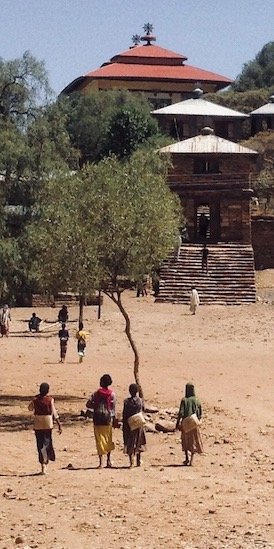The Role of Local Communities in Safeguarding Archaeological Sites in Northern Ethiopia
Marlene Köster M.A.
Supervisors: Dr. Britta Rudolff with Prof. Dr. Johanna Blokker

Various endeavors have been initiated in Ethiopia to safeguard its abundant cultural legacy. Western institutions, such as UNESCO, have been engaged in the country sincethe late 1960s. However, the outcomes have frequently fallen short of expectations. Similarly, the efforts of the German Archaeological Institute (DAI) in the Tigray region, specifically at the Yeha site where this study is centered, are directed towards the conservation and promotion of monuments for tourism. As nature and cultural tourism stands as a crucial economic asset, archaeological research is progressively intertwining with cultural preservation endeavors and tourism development, presenting a multifaceted challenge.
Beyond the prevailing political instability in the country, the impediments arise from deficient management strategies, inadequate expertise, and financial limitations, perpetuating reliance on foreign knowledge and financial support. Furthermore, disparities in the local comprehension of cultural heritage, frequently at odds with predominantly European or North American international concepts, contribute to the predicament. Additionally, notable distinctions exist within the country, contrasting the ideals of national politics with those of the urban, modern-educated populace and the rural residents. Particularly noteworthy is the intricate system of memories within the latter, intertwining cultural heritage with narratives and societal frameworks, thereby fostering its conservation. Despite this, the development of cultural resources has predominantly been spearheaded by foreign or Western criteria-aligned institutions, leading to the subjugation of local knowledge and structures to international standards, detrimentally impacting the perpetual preservation of cultural monuments.
In the Tigray region of northern Ethiopia, where DAI projects are centered, archaeological sites are frequently situated away from infrastructural, official, or touristic developed zones. Augmenting their preservation necessitates enhanced engagement of local stakeholders. Additionally, long-established regional and local structures often exhibit greater resilience compared to newer state institutions formed under Western funding initiatives, frequently overvalued in their efficacy.
This dissertation delves into the contribution of local communities to the safeguarding of archaeological sites in northern Ethiopia. Grounded in the premise that the enduring protection of cultural heritage mandates heightened community involvement, the research zeros in on the relationship between archaeological sites and surrounding communities in northern Ethiopia, using the Yeha site as a case study. Employing qualitative research methods, the objective is to gain a nuanced understanding of these interactions and, consequently, to advocate for sustainable conservation strategies by identifying challenges, conflicts, as well as opportunities and synergies stemming from increased participation.
